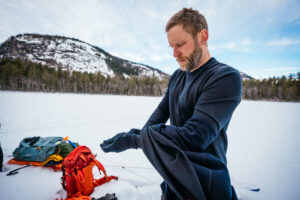GOLDILOCKS ZONE
By Eugene Buchanan

Whether you’re skinning up a snowy, jagged peak or taking an early-morning run on a foothills trail, what you wear against your skin determines how warm or cold—and comfortable and happy—you will be. This is the world of baselayers, a multi-billion-dollar business designed to help you perform better and stay more comfortable outdoors.
But how do they work, these magical garments that have become mainstays of consumers’ outdoor-apparel arsenal? For some insights, we went to industry leader Terramar, which has pioneered this field ever since the company was founded over 50 years ago in 1971.
“We’re committed to developing all-climate baselayers to keep our users warm and safe outdoors year-round,” says Terramar vice-president Miriam Lieberman. Since it first began importing oiled wool sweaters from the UK and knitted silk baselayers from China, Terramar’s mission has been to encourage people to explore and discover the outdoors, while improving their experience. Incorporating cutting-edge, proprietary technology and fabrics into its designs, it’s accomplished this by introducing Drywool in 1979, Thermasilk in 1982, Thermawool in 2007, and now its patented Climasense fiber fusion thermoregulation technology to warm you up when you’re cold and cool you down when you’re warm. The goal: letting you maintain ideal temperature and humidity while keeping your body temperature exactly where it needs to be.

How It Works
Your body regulates its temperature by sweating, which evaporates from your skin, causing it to cool. Sweat can evaporate from your baselayer as well, cooling your body when active and warming it when it’s cool.
Studies show that moisture conducts heat 25 times faster than air. If that moisture can’t escape the surface of your skin, you’ll get colder faster. A baselayer’s main function is to transport sweat away from your skin and toward the outer fabrics, helping you to regulate your body temperature. This process—absorbing and removing your sweat to keep you comfortable on the move—is called wicking. Terramar’s fibers do this by moving moisture from the inside to the surface, “wicking” away moisture from the body, keeping your skin dry (if your baselayer stays wet against your skin, it will cool you down). These fibers’ water-repelling properties move the sweat away from your skin so it can evaporate and get off your body, keeping you warm and dry.
And bigger, or thicker, isn’t always better. Insulation isn’t a baselayer’s main purpose; it’s not designed to trap heat. In fact, the thicker it is, the less effective it is at wicking moisture away. “Weight doesn’t always equal warmth,” says Terramar fabric developer Benjamin Smith. “When it comes to baselayers, heavier and thicker doesn’t always mean it will keep you warmer. The fibers and fabric construction can alter a baselayer’s warmth. We engineer knit constructions to inherently increase their ability to thermoregulate, transfer moisture, and dry faster.”
Terramar’s fabrics incorporate proprietary Climasense technology to help regulate warmth. The process involves infusing activated nano carbon into the fabrics to increase their surface area, which allows the fibers to quickly absorb warm vapor and sweat. This prevents overheating when active and speeds up dry time to avoid feeling wet and uncomfortable. It also gives them better thermal properties. All this makes them a versatile layer that can be worn anytime, keeping you warmer when it’s cold and cooler when it’s warm.
“As people are changing out their closets less frequently, it’s important to offer products that can be worn in all climates, year-round,” says Terramar brand manager Kathryn Sitarz, touting its most recent launch—Ventilator—as giving consumers a lightweight, temperature-regulating layer that can be worn year-round on its own in warm climates and as a baselayer in cooler ones.
“Innovation in fabric is at the forefront of our design team,” she adds, calling out Terramar’s Merino, Performance, and Heritage series, as well as its Climasense technology, all designed to regulate temperature and enhance comfort. “We engineer knit constructions to inherently increase their ability to transfer moisture, dry faster, and thermoregulate to enhance their performance. We’re constantly measuring how fast moisture moves from the skin to the face of the fabric—because the bottom line is keeping dry is the basis of keeping comfortable.”
